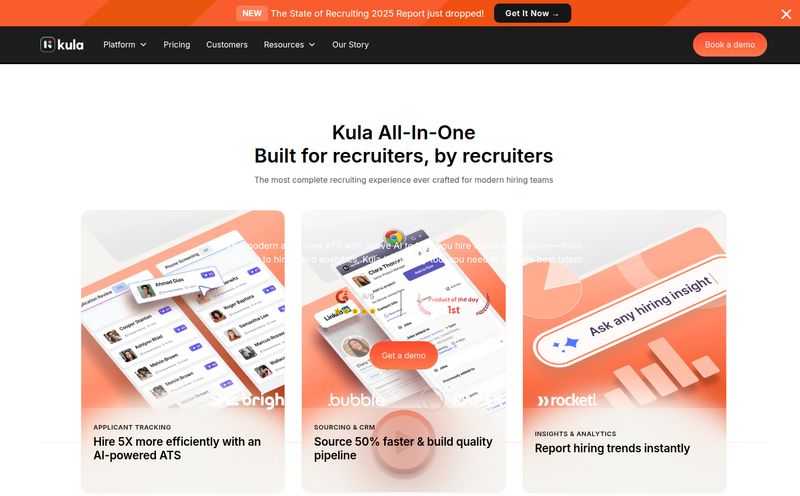If you're in the software world, you know the feeling. The sprint is done. The big feature is finally pushed to production. High-fives all around. But then, a shadow looms. A task so mundane, so tedious, it can suck the joy right out of a successful launch. I'm talking about writing the release notes.
For years, this has been the digital equivalent of doing the dishes after hosting a fantastic dinner party. Necessary, but a total drag. It's often handed off like a hot potato—from dev to product manager to marketing—with nobody really wanting it. The result? Rushed, inconsistent, jargon-filled updates that either confuse customers or get ignored entirely.
I've seen it a hundred times. I've lived it. But recently, I stumbled upon a tool that promised to take this particular chore off my plate. It’s called Release Notes.AI, and it claims to use the magic of GPT-3 to whip up your release notes for you. A bold claim. So, obviously, I had to see if it was just another AI gimmick or a genuine timesaver.
So, What Exactly is Release Notes.AI?
In a nutshell, it's a specialized AI tool designed to do one thing and one thing only: generate a first draft of your product's release notes. You feed it a few key details about your update—like what the feature is, whether it's a bug fix or a new addition, and who it's for—and it spits out a draft. The goal isn't to replace a human entirely, but to crush that initial writer's block and get you 80% of the way there in seconds. No more staring at a blank page while your coffee gets cold.
My First Impressions and Getting Started
Hopping onto their site, the first thing I saw was the sign-in page. It’s clean, minimalist, and gets straight to the point. No fluff. I’m a fan of that. They use a password-free sign-in, where they just email you a magic link. It's a small thing, but not having to remember yet another password is a little win in my book.

Visit Release Notes Simplified with GPT-3
The whole vibe feels very modern and developer-centric. It gives the impression that the creators understand their audience: people who value efficiency and want to get the job done without jumping through a bunch of hoops.
The Core of It: How This Thing Actually Works
Once you're in, the process is ridiculously straightforward. You're basically just filling out a simple form. You give your update a title, specify the type (New Feature, Improvement, Bug Fix), and write a few sentences describing what you shipped. The quality of your input here is... well, everything. We'll get to that in a moment.
After you plug in the details and hit 'generate', the AI does its thing. Within about 10-15 seconds, you have a draft. It's formatted, it has a friendly tone, and it's ready for you to review. It’s a pretty slick experience.
The Good Stuff: Why This Is a Genuine Help
The most immediate benefit is the sheer speed. I've personally wasted hours trying to translate technical git commits into something a normal human can understand. This tool slashes that time down to minutes. It’s a massive productivity boost, especially for small teams or indie developers where everyone wears multiple hats.
Another big plus is consistency. When different people write release notes, the tone and style can be all over the place. One week it's super formal, the next it's full of emojis. Using an AI to generate the base draft helps maintain a consistent voice for your brand, which builds trust and predictability for your users. It's a subtle but powerful part of the user experience.
The Not-So-Good Stuff: Where It Stumbles
Now, it's not perfect. Let's get that straight. The biggest caveat is something anyone who's used AI will know: Garbage In, Garbage Out. If you give the tool lazy, one-line descriptions, you're going to get a generic, lazy-sounding draft back. You have to provide some decent detail for it to create something truly useful. It’s a partner, not a mind-reader.
You also absolutely must edit the output. The AI might misunderstand a nuance, get a technical detail slightly wrong, or just sound a little too... robotic. It's a first draft, not a final copy. You still need a human eye to polish it, check for accuracy, and inject your brand's unique personality. Thinking you can just copy-paste without reading is a recipe for embarrassment.
Who Is This Tool Actually For?
I've been thinking about this a lot. Is this for a huge company like Microsoft? Probably not. They have entire teams of technical writers. But for certain people, this tool is a godsend. I'd say the sweet spot is:
- Indie Hackers & Solopreneurs: When you're doing everything yourself, automating a task like this is pure gold.
- Small to Mid-Sized SaaS Companies: Teams that are agile and ship frequently but don't have a dedicated writer will see a huge return on time saved.
- Product Managers: For PMs who get stuck with writing updates, this can free them up to focus on strategy and user feedback.
It's for anyone who understands the value of good communication but doesn't have the luxury of time to craft every update from scratch.
Let's Talk Money… Or Not? The Mysterious Pricing
So, here's where things get a bit weird. I went looking for the pricing page to see what this would set me back. And... 404. Page not found. This could mean a few things. Is the tool in a free beta? Is it a side project that isn't fully monetized yet? Or is the link just broken?
Honestly, I find this kind of charmingly real. It's a reminder that not every tool online is a polished, venture-backed machine. For now, it seems to be free to use, but that could change. My advice? If it looks interesting, jump in and try it while you can. There's no cost to see if it fits your workflow.
The Hidden Gem: Release Notes and Your SEO
Okay, time to put on my SEO hat. Most people see release notes as just customer comms, but they can be a surprisingly effective tool for traffic and user retention. Think about it. Every time you post an update, you're creating a new, indexed page of content for your site. Your changelog becomes a living document of your product's evolution.
If you name your features what your users would actually search for (e.g., "New Google Calendar Integration" instead of "Project Kronos Sync Module"), your release notes can start ranking for long-tail keywords. This brings in highly qualified traffic—people looking for the exact solution you just built. Furthermore, regular updates signal to Google that your site is active and maintained. And for users, seeing a steady stream of improvements shows them the product is alive and kicking, which can be a huge factor in reducing churn.
An AI release notes generator makes it easier to publish these updates consistently, turning a chore into a low-effort content marketing strategy.
Frequently Asked Questions
- What is Release Notes.AI?
- It's an AI-powered tool that uses GPT-3 to help you write the first draft of your software release notes, saving you time and effort.
- How does the AI generate the notes?
- You provide basic details about your update, such as a title, a short description, and the type of change (e.g., new feature, bug fix). The AI uses this information as a prompt to generate a more complete, user-friendly draft.
- Is Release Notes.AI free?
- As of this writing, there is no public pricing page, and it appears to be free to use. This could be because it's in beta or a new tool, so this might change in the future.
- Do I still need to edit the AI-generated release notes?
- Yes, absolutely. You should always review the draft for accuracy, tone, and clarity. Think of the tool as an assistant that gets you 80% of the way there, not a full replacement for a human editor.
- Can I use this for both internal and external updates?
- Definitely. It's great for drafting customer-facing announcements, but you could also use it to quickly summarize changes for internal teams, like sales or customer support, to keep everyone in the loop.
- What's the difference between this and just using ChatGPT?
- That's a great question. While you could create a complex prompt in ChatGPT to do something similar, Release Notes.AI is a purpose-built tool. It provides a structured workflow specifically for this task, which streamlines the process and ensures you don't miss key details. It's about convenience and focus.
The Final Word
So, is Release Notes.AI the magic bullet that will write all your updates for you forever? No. But it is an incredibly useful and practical tool that solves a very real, very annoying problem. It takes the pain out of starting and gives you a solid foundation to build on. It turns a dreaded task into a quick check-and-edit job.
For the right person—the busy developer, the overloaded product manager, the solo founder—this isn't just a novelty. It's a genuine productivity hack. It smooths out a rough edge in the development cycle, and in a world where we're all trying to do more with less, that's a pretty big win.
Reference and Sources
- Release Notes.AI Official Website
- OpenAI's Information on GPT-3
- Atlassian's Guide to Writing Effective Release Notes



